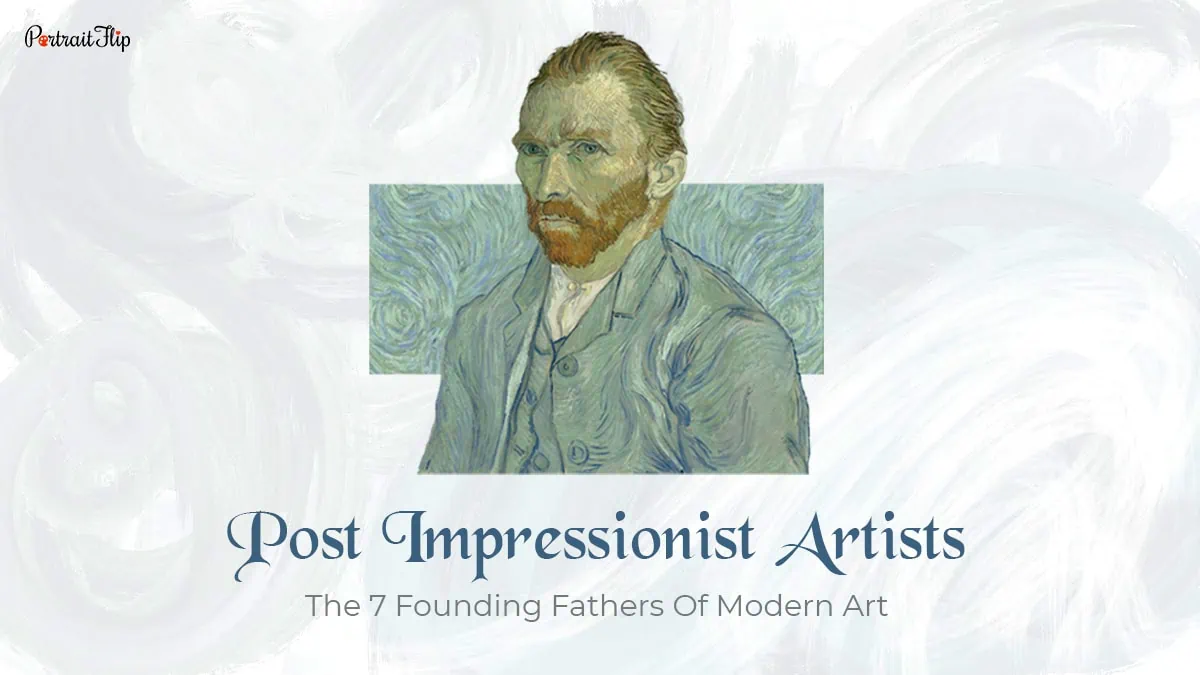Table of contents
France, the birthplace of most culture and art, saw the growth of yet another futuristic movement:
Post-Impressionism and Post-Impressionist artists!
The term “post-Impressionist artists” was coined by Roger Fry for the works of the likes of Paul Cézanne, Van Gogh, and others.
These artists are known to break free from the naturalistic painting of Impressionism and focus more on the subject’s feelings.
While Post Impressionist painters inherited a lot from the impressionist movement, they also deviated from the latter in the ways that were necessary.
Like Van Gogh would have said, “I dream of painting and then I paint my dream.”
Artists of Post-Impressionism took advantage of their imaginative power, an act of revolution against contextual art that sought to provide an accurate reflection of the world as it was perceived; an addition of a subjective filter.
By integrating these added dimensions into art, this highly influential movement became a vehicle through which expression of the subjective interpretation of life through the artist’s eyes was allowed.
But before we try to understand who these artists were, we need to understand the traits of a typical Post-Impressionist Painting.
Post Impressionist Artists’ Painting Styles & Characteristics
As soon as we hear Post Impressionist paintings, the first thing that strikes us is the alluring swirls of Van Gogh’s paintings.
But post-impressionists are more than just their vivid colors and bold brush strokes.
Let’s look at some dominating traits that mark a painting as the work of a true Post Impressionist painter.
1. Pointillism
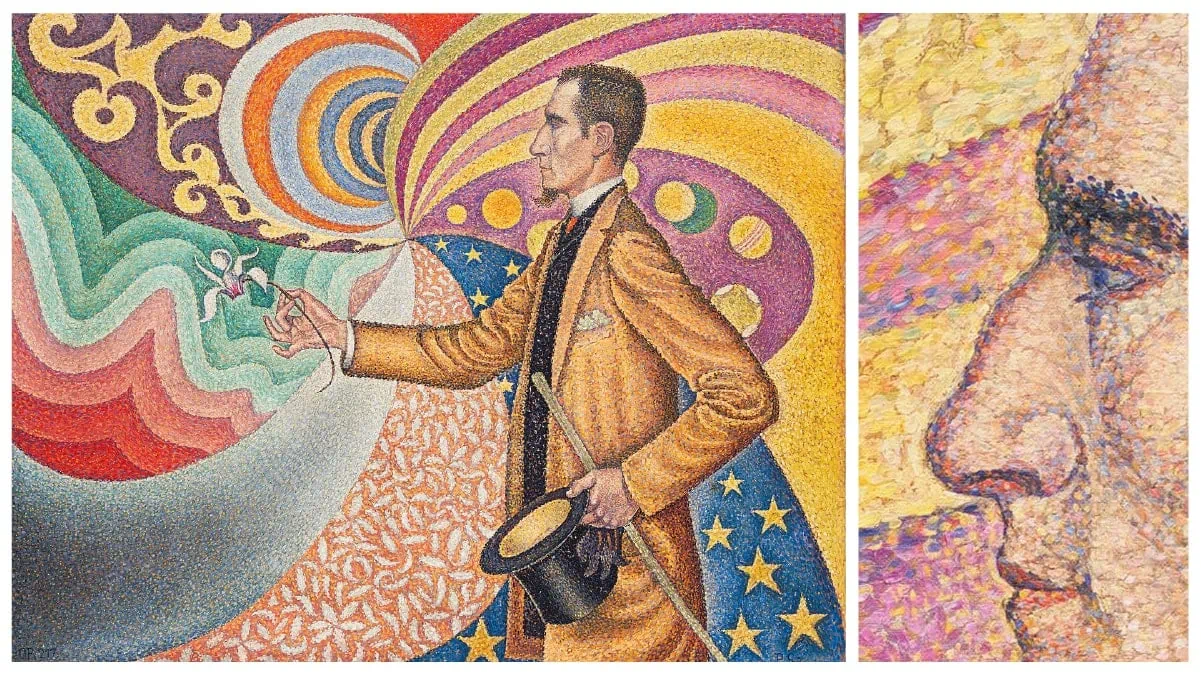
As the name suggests, Pointillism is the application of tiny strokes of colors or dots to create the effect of continuous color when looked at from a distance.
Also referred to as Divisionism, to break from the distinct brushstrokes of the Impressionist, Seurat took the more methodical approach of using dots in order to create an illusion of continuity.
2. Synthetism
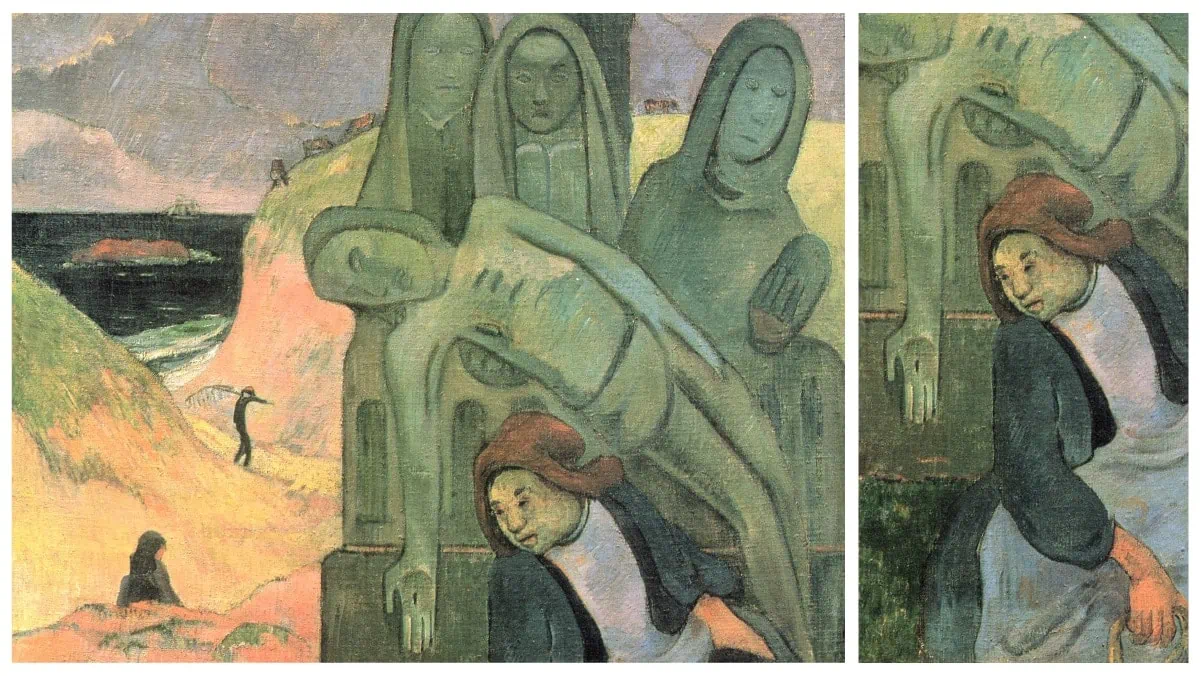
The move from the depiction of real life towards the symbolic approach of representing the world happens to be known as Synthetism.
Instead of struggling to show the world a hyper-realistic portrayal of the subject, artists who believed in Synthetism allowed some room for the inclusion of their emotive interpretation of what they saw.
This also allowed the artists the freedom to paint from imagination with no burden of achieving the perfect stroke.
3. Japonisme

Works inspired by the Ukiyo-e prints were referred to as the Japonisme style of painting.
The main feature of this painting style was the use of less symmetry and more superimposition of near and far objects.
The perspective in the paintings was also affected in a way that reflected a bold step away from the need to depict the reality of nature objectively. This style was particularly evident in Van Gogh’s work.
Own one of the Gogh’s artwork which is as real as the original. Check out Van’s replica paintings now!
4. Pictorial Form

Another distinct style that made an appearance in the revolutionary movement was the contradictory turn in its emphasis on form.
Using basic geometric shapes as the foundation upon which the complexities of the picture were built.
The primary subject matter included landscapes, still life paintings, and portraits, unlike the two-dimensionality that was typical of synthetism.
(Also Read: 9 Artists of Pop Art Who Rejected The Notion Of Uniqueness)
5. Primitivism

Primitivism alludes particularly to the works of Henri Rousseau but also to some extent inspired the works of Pablo Picasso.
In the post-impressionist artists’ never-ending quest for symbolism, Primitivism featured as one style that struck their fancy.
Primitivism served as the base for the artists of Cubism and surrealism.
The idea was to emulate or recreate a “primitive” experience through their artist’s imagination.
The use of tribal figures, the influence of “Negro art” and an underlining sense of ethnographic form is what Primitivism primarily focused on.
6. Les Nabis

Les Nabis was strongly influenced by Synthetism and was a transition from Impressionism to abstract art.
Alternatively known as the creator of subjective art, Le Nabis focused way too much on the depiction of the soul.
7. Colors and Brushstrokes
Like their ancestors, even Post Impressionist artists were not resistant to the use of bright colors. The only difference was that they used colors more liberally without caring much about how they would appear.
Most of the time, colors were intentionally used the elicit emotions from the viewers, regardless of the viewer’s relationship with the color that was expected or considered to be accurate.
Post Impressionist artists were known for their unforgivingly distinct use of brush strokes to create greater depth and to give viewers the sense that the artwork was not intended to be an objective reflection of nature or the landscape that the artist wanted to depict.
So now that we have a brief idea of what the painting of Post Impressionism looked like, it is time we get to know about the maestros associated with this movement.
Suggested Read: Paintings by Kandinsky
Famous Post Impressionist Artists and Their Works
While post-impressionist artists often exhibited their works together, they were not always in agreement about the characteristics of post-impressionism.
One can say that they did not really want to be labeled under one huge -ism. Although strikingly similar in style, it was not necessarily a cohesive movement.
An overarching commonality however was the favoring of abstraction over naturalism.
Despite their differences, here the most famous Post Impressionist Artists sculpted modern art and continued to awestruck others with their art.
Starting with the father of Post Impressionism:
1. Paul Cèzanne

Known as the Almighty himself, Paul Cèzanne (1839-1906), was said to have laid the bricks for modernism and formed the bridge between Impressionism and Cubism.
Although considered a Post-Impressionist, he had a larger influence on the Cubists.
He started off early with pictures of romantic and classical themes imbued with dark colors and executed with expressive brushwork.
Dramatic tonal contrasts and thick layers of pigment were always a dominating feature in Cèzanne’s works.
His landscape paintings later, however, abandoned dark palettes in exchange for brilliant tones and he began painting out of doors.
In his still-life paintings, Cèzanne also abandoned his thickly encrusted surfaces and began to address technical problems of form and color by experimenting with a subtly gradated tonal variation or “constructive brushstrokes” to create an angle and dimension to his objects.
But what remains Cèzanne’s most famous work of art was his series of five pictures of Provençal peasants playing cards.
The Card Players
Widely celebrated as among the finest figure compositions, The Card Players demonstrates his system of color gradations to build form and create three-dimensional quality in the figures.
Interestingly, The Card Players defied the emotional convention of such a scene.
Similar scenarios in 17th-century Dutch and French art were defined by drama. But Cèzanne’s take on the card players was true to his style of muted emotion. Instead, his scene is so quiet it has been described as “human still life.”
2. Paul Gauguin
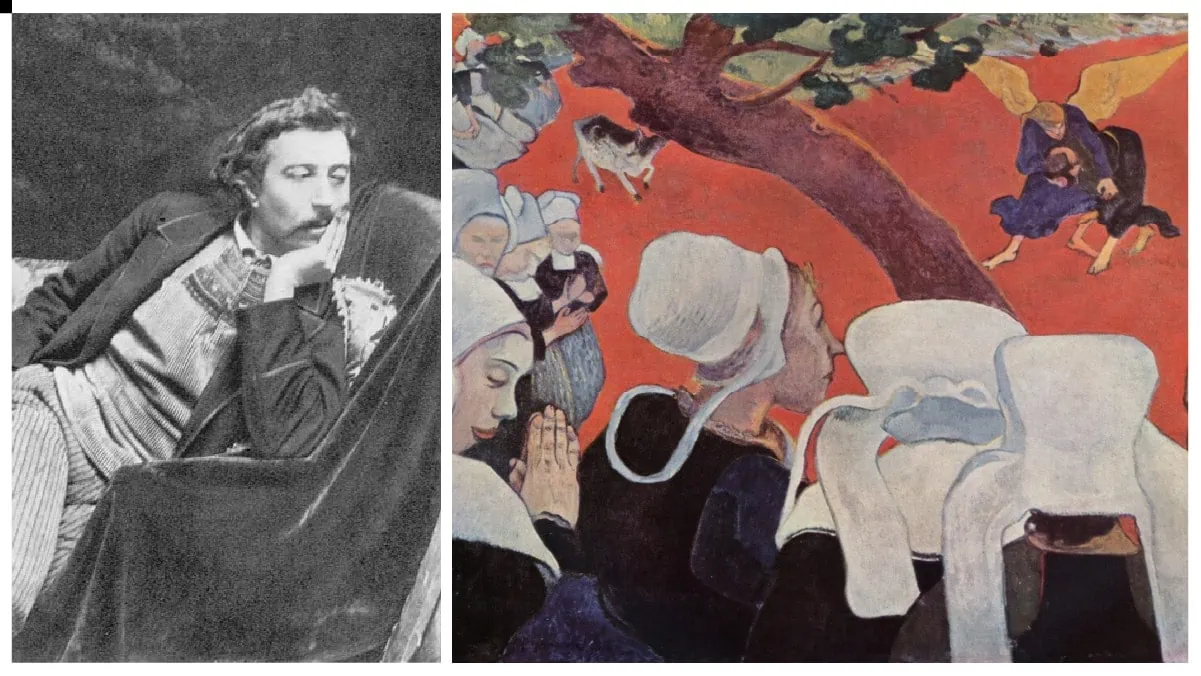
Widely known for this experimental use of color and Synthetist style, and notorious for getting involved in a heated argument with van Gogh, Paul Gauguin is another interesting Post-Impressionist artist.
Gauguin has a fascination for Symbolism and explored new color theories and semi-decorative approaches to painting.
He famously worked one summer in an intensely colorful style alongside Van Gogh before turning his back entirely on Western society.
Paul Gauguin’s painting married everyday observations with mystical symbolism, a style strongly influenced by popular Primitive art.
While Gauguin’s name remains synonymous with the idea of ultimate artistic freedom, there is one particular piece of art that will always be remembered as his best work.
The Vision After The Sermon
The Vision After the Sermon is one of Gauguin’s most famous paintings in oil.
The painting depicts a group of women leaving a church, after having heard a sermon about Jacob fighting the angel, as described in Genesis in the bible.
The peasant women in the painting witness the angelic battle in front of their eyes.
The superimposition of the mythological realm with the depiction of the ordinary scene of a gathering of women is an example of how Post-Impressionist artists juxtaposed imaginal elements with everyday scenes – a characteristic trait of the post-impressionist enterprise.
This piece is also a classic example of the movement away from the Impressionist inclination toward formlessness in their paintings.
So in this painting, we can witness a movement toward solid, two-dimensional areas of color and clearly defined forms.
These qualities form the backbone of what Gauguin dubbed the Synthesist movement.
3. Henri Rousseau

If any Post Impressionist artist was known for painting jungle scenes, it was Henri Rousseau, even though he never left France and saw a jungle.
Mostly self-taught, Rousseau always said that nature was his only teacher.
Henri Rousseau’s paintings were a work of imagination.
Apart from the illustrated books and botanical gardens in Paris, Rousseau was in frequent conversations with soldiers.
He spent most of his time listening to their stories of the subtropical countries they had encountered.
He described his visits to the Jardin des Plantes, a famous botanical garden in France,
“When I go into the glass houses and I see the strange plants of exotic lands, it seems to me that I enter into a dream.”
Known for having a lot of critics, this post impressionist painter’s childish style took some by shock and was ridiculed by others.
Many observers disregarded his painting as a child’s work of art and he struggled hard to be of acceptance as an artist of his era.
Despite his plight, Rousseau believed to have invented a new style in landscape paintings where the painting had a backdrop of his favorite part of the suburb or city with only one figure in the foreground.
For instance:
The Dream
A nude woman reclining on a sofa in a jungle setting is pretty much was Rousseau was all about.
The viewer is strongly taken by a violent sense of the jungle with wild animals poised throughout the painting.
A snake slithers through the painting while monkeys play in the trees and an elephant lurks in the background. There are colorful birds depicted too.
There is a lion and a lioness who appear to be stalking their prey.
One can be the seated young woman and the other perhaps the viewer.
The jungle scene also bursts with meticulously crafted foliage and flowers, including brilliant orange trees and shaded banana trees.
Rousseau is said to have used 22 different colors of green alone in creating his jungle painting.
The Dream painting also depicts a native woman most likely a snake charmer, playing an instrument.
This unusual mixture of a classical nude within an exotic jungle setting completed with a snake charmer is one of the juxtapositions that makes a viewer step back and question the meaning and possible interpretations of the painting.
Over the years, millions of admirers have offered a multitude of possibilities for what is happening in what many call “The Dream Rousseau Painting.”
4. Henri de Toulouse-Lautrec
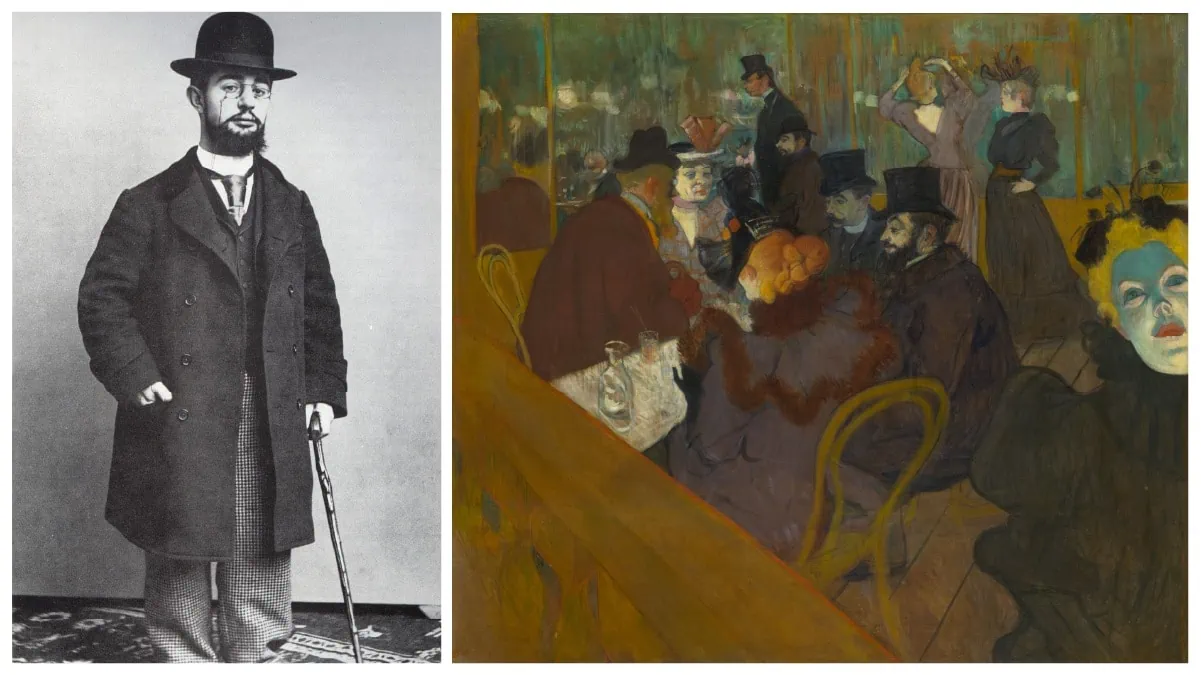
Two major lifestyle changes in Paris saw the emergence of an aristocratic, alcoholic dwarf, Henri de Toulouse-Lautrec as an artist of post impressionism.
The birth of modern printmaking and a sudden increase in nightlife culture made this artist famous.
Lautrec’s posters promoted Montmarte entertainers as celebrities and advanced lithographic advertising as a form of liberal arts.
New innovations in lithography gave him the freedom to experiment with dazzling technical effects in his prints.
From the time he was studying art in college, prostitutes became his subject of admiration.
Most of his paintings consisted of hall dancers and prostitutes as an attempt to capture their sadness in a personal and humanistic way.
Though Lautrec died a very young death, he created a new pathway for digital prints and designers.
If one could allow, Andy Warhol and pop art paintings are two best gifts that Lautrec’s art could give the world!
Let’s have a look at one of his most famous prints.
At The Moulin Rouge
At the Moulin Rouge, the dance was a masterpiece from the very title of it.
While the entire painting shows men and women flocking in the famous Moulin Rouge, two subjects clearly stand out.
One, an elegant lady dressed in pink and the dancer.
The rest is but an accurate depiction of a noisy and endlessly crowded cabaret’s ambiance.
Interestingly the artwork introduced Valentin le Désossé, a famous dancer and contortionist of the time (that’s the man in black dancing).
Opposite Valentine is a young woman wearing high boots and completing a step of French Cancan.
In contrast to her dull and un-jeweled appearance stands an elegant woman with poise.
Her presence comes as a surprise in a cabaret considering it a place of “vulgar” entertainment and corruption.
She is shown as an educated and respectable woman as opposed to the eccentric and carefree dancer.
The painting also shows a sea full of top hats standing around the bar with a high influence of 1890s fashion.
No wonder the bar owner was impressed by the print and decided to hang it about the bar.
5. Odilon Redon

Known to create “dreamlike” prints, Odilon Redon was a famous printmaker, symbolist painter, and pastellist.
Both before and after the fight in the Franco-Prussian, he spent most of his time working with Charcoal and Lithography which were started to be called noirs.
It was only after late 1800 that Redon started painting in oil and pastel mediums which soon became a foil to his noirs.
He encountered the Nabis who slowly expanded his painting style and introduced him to more aesthetic and decorative art.
She started incorporating Japonism as well as flat, abstract patterns.
When asked in an interview about his favorite subject of art, Redon replied, “My monsters. I believe that it is there that I have given my most personal note.”
His “monsters” were often Chimera, either human-animal or human-plant, which was a result of his own vivid imagination.
It could have been the influence of Charles Darwin who came up with the theory that humans had animal ancestors.
His works were inspired by the Hindu and Buddhist cultures and were well-flirted with abstraction while he continued to take inspiration from nature.
If it were not for post-impressionist artists like Redon, the world would not be able to see the emergence of Dadaism and Surrealism.
With this here’s a print by Redon that has stayed with me for a while.
The Eye, Like A Strange Balloon Moves Towards Infinity
An eyeball morphed into the shape of a balloon with its gaze upwards slowly rising above the horizon, that is what Redon was capable of.
But unlike a hot air balloon that carries people, this one was carrying a severed head which resembled the St. John the Baptist from the Salmone episode of the Bible.
With a sky full of thick clouds and ground full of palm trees, this painting was the peak of symbolism.
In most art and literature, a severed head and departed eye were a symbol of freedom from the everyday hustle of life.
According to Hindu and Buddhist scriptures, it also meant the attainment of high consciousness.
A scholar and curator Jodi Hauptman writes, “floating up ‘towards infinity’, let loose from the limitations of body and mind, Redon’s eyes are free to really see, beyond reality, beyond nature, beyond the visible.”
Redon was massively inspired by writers like Edgar Allen Poe and Gustav Flaubert whose unusual sensibility complemented his.
This work was also included in his portfolio of six lithographs, Edgar Poe, and has become one of his most famous works by him.
Not to consider this as an illustration of Poe’s poetry but as a correspondence of it!
6. Vincent van Gogh
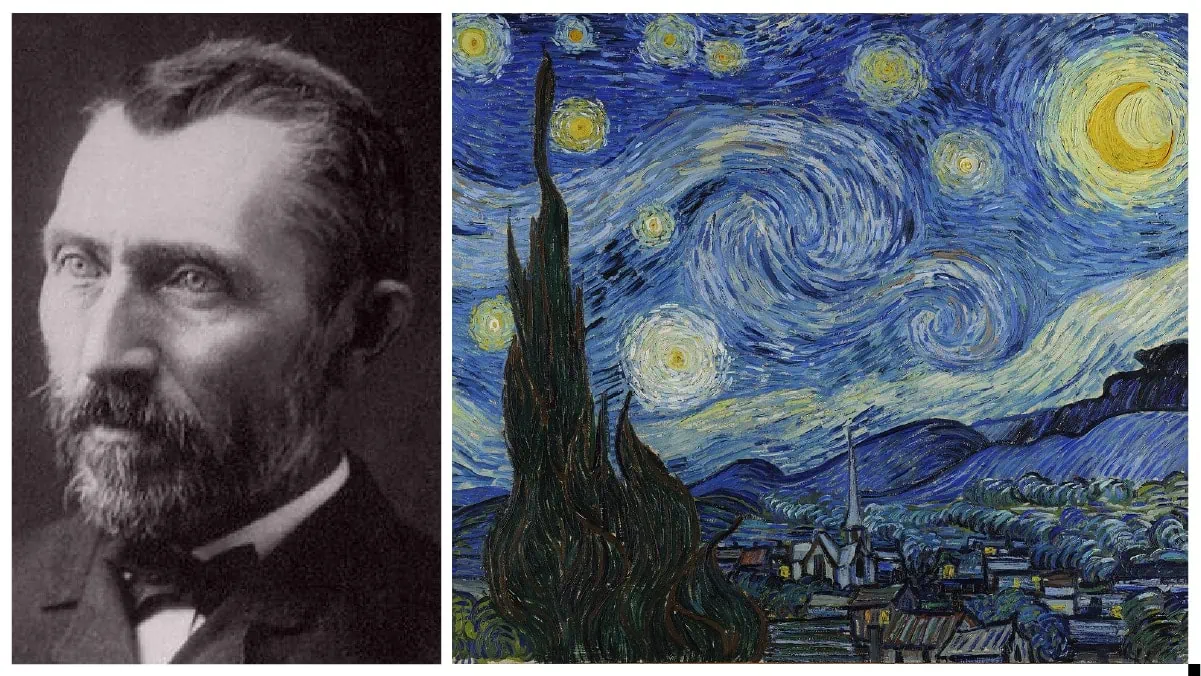
French Post Impressionist artists can never be spoken about without utterance of the name Vincent van Gogh.
Although Dutch in origin, van Gogh created his best works in France.
Van Gogh, also known as a tortured artist was notable for bringing beauty, emotion, and vibrancy to his work of art.
Although posthumously, he became one of the most influential and important figures of Western art with more than 2000 works to his name.
His works included landscape paintings, self-portraits, and still portraits but what caught the viewer’s attention was his use of bold colors, dramatic brushwork, and impulsive and expressive subjects.
Said to have a homosexual affair with none other than Paul Gaugin, he was not only in love with him but also highly inspired by his work of art.
So much so that this artist has an experimental movie, Loving Vincent, to his name.
While van Gogh spent most of his life in mental turmoil, his paintings always looked at the colorful side of life.
One such painting known by the world is
The Starry Night
The Starry Night is a semi-abstract landscape painting of an expressive night sky that van Gogh could see from his room in the mental asylum.
After a series of mental breakdowns, van Gogh lived in an asylum where all he could paint was the surroundings.
The oil-on-canvas is dominated by a night sky rolling in chromatic blue swirls that make the most striking element of the painting.
In contrast, stands the big, bright stars resembling the astronomical observations in Sant-Remy-de-Provence on May 25th of 1889.
One or two cypress trees try to rise towards the sky violently symbolizing death as the only way to experience life beyond physical realms.
The painting looks just a romanticized version of the night but is in fact, much more symbolic when one tries to dig deeper.
It is one of the most studied paintings in art schools and will always remain at the core of every art lover.
(Also Read: 19 Famous Impressionist Paintings)
7. Pierre Bonnard

If any artist loved intense colors in the entire list of Post Impressionist artists, then it would be Pierre Bonnard.
He could give the sense of bright sunlight outside as well as artificial light indoors.
Bonnard flooded his painting to an extent that it used to overpower the subject of the painting.
But what is most interesting is that Pierre Bonnard was one of the very few artists of was actually a part of Les Nabis.
Nabis came from a Hebrew word that meant “The Prophet”. Bonnard and other Les Nabis considered themselves the Prophet of Modern Art.
More than just calling themselves Les Nabis, they were known for their decorative curvilinear compositions and intimate domestic scenes.
In fact, Bonnard’s paintings of charming interiors lighted by oil lamps, nudes on voluptuous beds, and Montmartre scenes made him a recorder of France’s Belle Époque.
A lot of art fanatics may not know but Pierre Bonnard is also the painter of one of the famous cat paintings, The White Cat.
Bonnard’s ability as a large-scale decorator is sometimes overlooked, in view of his more quiet, domestic paintings in the Intimist style.
But even today, he remains an artist who loved to work on multiple paintings together and all with his memory!
And so, here’s a painting that Bonnard was most famous for!
Nude Crouching In The Tub
It is hard to think about Bonnard without Marthe. Marthe de Méligny appears throughout Bonnard’s work.
She was his partner for 50 years despite him having an affair with multiple younger women.
Marthe was not only his confidante but also his favorite model and satiated his fascination for depicting naked women involved in everyday chores.
Nude Crouching in the Tub is also a depiction of Marthe getting into her bathtub for a shower.
Almost unbothered by the artist’s intrusion, she calmly pours the water for her bath.
The painting was caught in the motion of a domestic activity but it does not reveal the face or details of the body.
The main focus of the painting is directed toward the use of colors. A very Les Nabis trait.
Interestingly, Bonnard also became more famous for his nude paintings than his domestic artworks.
And with this, we come to the end of the list of post impressionist artists.
But like every art movement, Post Impressionists could not have emerged, if not for a transition.
Although none could set them apart from Post-Impressionist they still had a more classical approach to painting.
What they did do was become the foundation for great artists like Gauguin and van Gogh.
This section is for unsung heroes.
Introducing the Neo-Impressionist.
Almost Post-Impressionist!
Before the Post-Impressionist movement, there were a few artists who tried to break apart from the Impressionist style of painting.
Although they were not entirely called the Post-Impressionist, they served more as a precursor to the movement.
Mostly using styles like Pointillism and Divisionism, they can be considered the founding figures of the Post-Impressionist era.
Starting with the best…

1. Georges Seurat
Although considered a Post-Impressionist artist by a few art critics, Georges Seurat was in fact the pioneer of Neo-Impressionists.
He introduced the painting technique associated with a softly flickering surface of small dots or strokes of color which would be later known as Pointillism.
New quasi-scientific theories about color made him innovate and create graceful works of art.
He believed that lines moving in certain directions with colors of a particular warmth or coolness could have different expressive effects.
Alongside, he discovered that contrasting or complementary color can optically mix to produce more vivid tones.
Chromo-luminism, to be better known as Divisionism, will be seen in a lot of works of Post-Impressionist artists.
Although his initial work of art was more classical in nature, he later took up more dynamic stylizing and expression of form.
Soon he would also come to be known as eccentric and a maverick by the Surrealists.
Major Works:
Bathers at Asnières (1884);
Sunday Afternoon on the Island of La Grand Jatte (1884-86);
La Seine à la Grande-Jatte (1888);
Image: artmajeur

2. Paul Signac
How can we speak of George Seurat without speaking of Paul Signac?
Signac was another French Neo-Impressionist artist who worked along with Seurat to create the Pointillist Style.
He primarily focused on creating landscape and sea view paintings with the help of the newfound style of art.
A leading theorist on the subject of color in painting, he always tried to experiment with different ways of applying paint.
A clear influence from various art schools notably Fauvism, Les Nabis especially the works of Henri Matisse.
Besides, Signac was an expert in various mediums including oil, acrylic, etching, and lithography.
An interesting fact suggests that Signac used to apply paint wet on wet, without waiting for the layers to dry up to get a softer result and better mixing of colors.
Major Works:
The Road to Gennevilliers (1883);
Still Life with a Book (1883);
Rue Caulaincourt: Mills on Montmarte (1884).
Image: wikipedia

3. Georges Lemmen
George Lemmen, the first Neo-Impressionist from Belgian was a painter, engraver, draftsman, and designer.
Highly fascinated by Degas and Toulouse-Lautrec, he joined the Brussels avant-garde group Les Vingt.
But later he adopted the Neo-Impressionism style under influence of Théo van Rysselberghe and started using the technique to paint numerous landscapes and portraits.
All of the Neo-Impressionist artists were greatly impacted by Seurat’s death in 1891.
However, Lemmen abandoned Pointillism and began painting in an Impressionist style that was more traditional, though his colors were closer to those of the Nabis.
But he did not limit himself to artworks. There were a number of book illustrations, posters, ceramics, carpets, drawings, pastels, and gouaches in his extensive work lists.
Major Works:
The Two Sisters or The Serruys Sisters (1894);
Thames Scene, the Elevator, ca. (1890);
Portrait de Madame Dumont Wilden (1909);
Image: wikipedia
The End!
Post-Impressionism has not only brought a new dawn in modern art but has been able to give the world great artists.
While there continued to come more artists and movements, no art critic can deny that none came like Post-Impressionists.
Through their radically independent styles and dedication to pursuing unique means of artistic expression, the Post-Impressionists dramatically influenced generations of artists.
However, as per the most recent study, Post-Impressionism has been strictly concentrated between 1886-1914.
Post-war came the Era of Abstraction.
With this, we come to the end of the list of the maestros of Post Impressionism.
But I have something interesting for you.
Read More: Famous Renaissance Artists That Ruled Over The Art World.
Attention Readers!
We bring to you high-quality reproduction paintings of all the Post-Impressionist artists including Vincent Van Gogh, Paul Cézanne, and others.
All you have to do is send us the painting and we will reproduce it at an affordable price.
I hope this piece added value to your knowledge of Post Impressionist Artist.
If you enjoyed this article, I recommend you to read my article on the Paintings of Frida Kahlo.
Follow us on Instagram and subscribe to our YouTube channel for more such content.
Did I forget to mention any artists? Do let me know in the comment section.
Until then,
Cheers!
FAQs
The four main post-impressionist artists are Paul Cezanne, Paul Gauguin, Georges Seurat and Vincent van Gogh.
Paul Cézanne is the father of Post-Impressionism.
Post-impressionism is a French art movement that was developed roughly between 1886 and 1905.
This art is known for not accepting the ordinary but instead looking for memories and emotions in order to connect on a deeper level.



